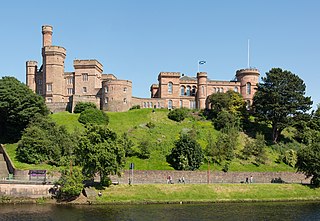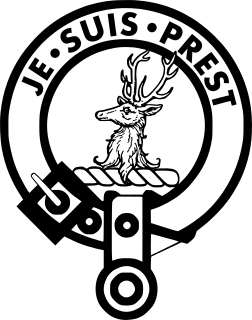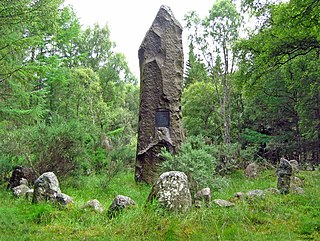
Clan Mackenzie is a Scottish clan, traditionally associated with Kintail and lands in Ross-shire in the Scottish Highlands. Traditional genealogies trace the ancestors of the Mackenzie chiefs to the 12th century. However, the earliest Mackenzie chief recorded by contemporary evidence is Alexander Mackenzie of Kintail who died some time after 1471. Traditionally, during the Wars of Scottish Independence, the Mackenzies supported Robert the Bruce, but feuded with the Earls of Ross in the latter part of the 14th century. During the 15th and 16th-centuries the Mackenzies feuded with the neighboring clans of Munro and MacDonald. In the 17th century the Mackenzie chief was made Earl of Seaforth in the peerage of Scotland. During the Scottish Civil War of the 17th century the Mackenzies largely supported the Royalists. During the Jacobite rising of 1715 the chief and clan of Mackenzie supported the Jacobite cause. However, during the Jacobite rising of 1745 the clan was divided with the chief, Kenneth Mackenzie, Lord Fortrose, supporting the British-Hanoverian Government and his relative, George Mackenzie, 3rd Earl of Cromartie, supporting the Jacobites.

Clan Mackintosh is a Scottish clan from Inverness in the Scottish Highlands. The chiefs of the clan are the Mackintoshes of Mackintosh. Another branch of the clan, the Mackintoshes of Torcastle, are the chiefs of Clan Chattan, a historic confederation of clans.

Inverness Castle sits on a cliff overlooking the River Ness in Inverness, Scotland. The red sandstone structure, displaying an early castellated style, is the work of a few 19th-century architects. William Burn (1789–1870) designed the Sheriff Court, Joseph Mitchell (1803–1883) the bastioned enclosing walls, and Thomas Brown II the District Court, originally built as a prison. It is built on the site of an 11th-century defensive structure. Until 30 March 2020, it housed Inverness Sheriff Court: this has now been moved to the Inverness Justice Centre.

Clan Fraser of Lovat is a Highland Scottish clan. The Clan Fraser of Lovat has been strongly associated with Inverness and the surrounding area since the Clan's founder gained lands there in the 13th century, but Lovat is in fact a junior branch of the Clan Fraser who were based in the Aberdeenshire area. Both the Clan Fraser and the Clan Fraser of Lovat have their own separate clan chiefs who are recognized by the Lord Lyon King of Arms under Scottish law. The Clan Fraser of Lovat in Inverness-shire has historically dominated local politics and been active in every major military conflict involving Scotland. It has also played a considerable role in most major political turmoils. "Fraser" remains the most prominent family name within the Inverness area.

Clan Sutherland is a Highland Scottish clan whose traditional territory is the shire of Sutherland in the far north of Scotland. The chief of the clan was also the powerful Earl of Sutherland, however in the early 16th century this title passed through marriage to a younger son of the chief of Clan Gordon. The current chief is Alistair Sutherland who holds the title Earl of Sutherland.

Clan Rose is a Scottish clan of the Scottish Highlands.
Robert Monro, was a famous Scottish General, from the Clan Munro of Ross-shire, Scotland. He held command in the Swedish army under Gustavus Adolphus during Thirty Years' War. He also fought for the Scottish Covenanters during the Bishop's Wars in Scotland and commanded the Scottish Covenanter army during the Irish Confederate Wars. He was the author of a diary recounting his military experiences during the Thirty Years' War, published as Monro, His Expedition With the Worthy Scots Regiment Called Mac-Keys.

Castle Chanonry of Ross, also known as Seaforth Castle, was located in the town of Fortrose, to the north-east of Inverness, on the peninsula known as the Black Isle, Highland, Scotland. Nothing now remains of the castle. The castle was also known as Canonry or Chanonrie of Ross, the former county.
The Munros of Milntown were a family cadet branch of the Highland Clan Munro. As the earliest recorded cadet branch of the Munro chiefs, the Munros of Milntown were the 'senior' cadet branch of the clan, and spawned many cadet branches. They were frequently recorded as 'Monro' as well as Munro. The Munros of Milntown are notable for being involved in events concerning the history of the late Middle Ages in the Scottish Highlands.

The Battle of Bealach nam Broig was a battle fought between Scottish clans from the lands of north-west Ross, against north-eastern clans of Ross who supported the Earl of Ross. The actual date of the battle is debated, it probably occurred in 1452 but the Conflicts of the Clans suggests a date as early as 1299.

The Battle of Logiebride or Logie-Riach, also known as a Tumult in Ross was more of a small skirmish rather than an actual battle. The disturbance is said to have taken place on 4 February 1597 at the Logie Candlemas market near Conan House between men of the Clan Mackenzie against men of the Clan Munro and the Bain family of Tulloch Castle.
Robert Mor Munro, 15th Baron of Foulis, and 18th chief of the Clan Munro was a 16th-century Scottish chief. He was known as Robert Mor on account of his large stature. He was the eldest son of Robert Munro, 14th Baron of Foulis. Although this Robert Munro is traditionally 15th Baron and 18th overall chief of the clan, he is only the 8th Munro chief that can be proved by contemporary evidence.

The Battle of Corrichie, also known as the Battle of Corrichy was a battle fought near Meikle Tap, near Aberdeen, Scotland, on 28 October 1562. It was fought between the forces of George Gordon, 4th Earl of Huntly, chief of Clan Gordon, against the forces of Mary, Queen of Scots, under James Stewart, 1st Earl of Moray.
Elizabeth Gordon, Countess of Huntly, was a Scottish noblewoman and the wife of George Gordon, 4th Earl of Huntly, Scotland's leading Catholic magnate during the reign of Mary, Queen of Scots. In 1562, Elizabeth encouraged her husband to raise forces against Queen Mary which led to his being outlawed, and after his death, his titles forfeited to the Crown. Elizabeth's son Sir John Gordon was executed for having taken part in his father's rebellion.
Kenneth Mackenzie, was the 10th laird of Kintail and he was nicknamed Coinneach na Cuirc in Scottish Gaelic, was a Highland chief, head of the Clan Mackenzie, who flourished in the turbulent Scottish politics of the mid-16th century.

Clan Munro is a Highland Scottish clan. Historically the clan was based in Easter Ross in the Scottish Highlands. Traditional origins of the clan give its founder as Donald Munro who came from the north of Ireland and settled in Scotland in the eleventh century, though its true founder may have lived much later. It is also a strong tradition that the Munro chiefs supported Robert the Bruce during the Wars of Scottish Independence. The first proven clan chief on record however is Robert de Munro who died in 1369; his father is mentioned but not named in a number of charters. The clan chiefs originally held land principally at Findon on the Black Isle but exchanged it in 1350 for Estirfowlys. Robert's son Hugh who died in 1425 was the first of the family to be styled "of Foulis", despite which clan genealogies describe him as 9th baron.

The Skirmish of Alness was a conflict that took place in October 1715 in Alness, in the county of Ross in the Scottish Highlands. It was part of the Jacobite rising of 1715 and pitted Highlanders loyal to the British-Hanoverian Government of George I of Great Britain against Highlanders loyal to the Jacobite House of Stuart.

The siege of Brahan took place in Scotland in November 1715 and was part of the Jacobite rising of 1715. Highlanders loyal to the British-Hanoverian government of George I of Great Britain laid siege to Brahan Castle, seat of William Mackenzie, 5th Earl of Seaforth, who was a staunch Jacobite, loyal to the House of Stuart.

The Marian civil war in Scotland (1568–1573) was a period of conflict which followed the abdication of Mary, Queen of Scots, and her escape from Lochleven Castle in May 1568. Those who ruled in the name of her infant son James VI fought against the supporters of the Queen, who was exiled in England. Edinburgh Castle, which was garrisoned in her name, became the focus of the conflict and surrendered only after an English intervention in May 1573. The conflict in 1570 was called an "intestine war in the bowels of this commonwealth", and the period was called soon after an "intestine war driven by questions against authority."
Lachlan Mor Mackintosh, 16th of Mackintosh was the chief of the Clan Mackintosh, a Scottish clan of the Scottish Highlands. He was also chief of the confederation of clans that was known as the Clan Chattan.














